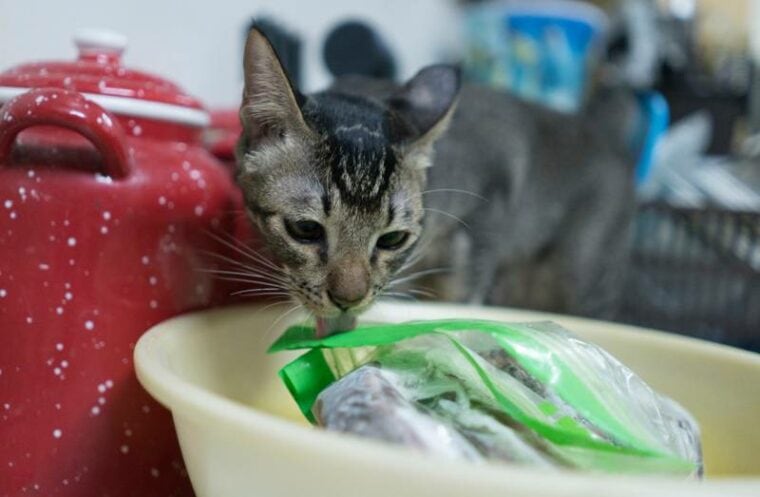
Cats, our enigmatic feline companions, often engage in peculiar behaviors that leave us both fascinated and perplexed. Among these intriguing habits, one that frequently piques the curiosity of cat owners and enthusiasts alike is their penchant for licking plastic objects.
Whether it’s the crinkly allure of a plastic bag, the smooth surface of a Tupperware lid, or the allure of seemingly mundane packaging materials, cats seem inexplicably drawn to this synthetic material.
But why do they lick plastics? Cats, as curious as they are, may be attracted to the smell, texture, and even the lingering taste of these plastics that triggers their innate hunting instincts. But while it may seem like a very simple answer, there are other things that need to be considered when it comes to this behavior.
Still curious? Read on as we discuss why cats exhibit this peculiar behavior!
Is It Normal Behavior for Cats to Lick Plastic?
While cats licking plastic may seem unusual to us, it is not entirely uncommon behavior among our feline companions. Some cats are inexplicably drawn to plastic objects, which can include plastic bags, packaging materials, or even plastic food containers.
However, it’s essential to note that the frequency and intensity of this behavior can vary from one cat to another. While it may be considered normal for some cats, excessive or compulsive plastic licking could be indicative of underlying health issues or stress, warranting a closer look and potential consultation with a veterinarian to ensure the well-being of your furry friend.
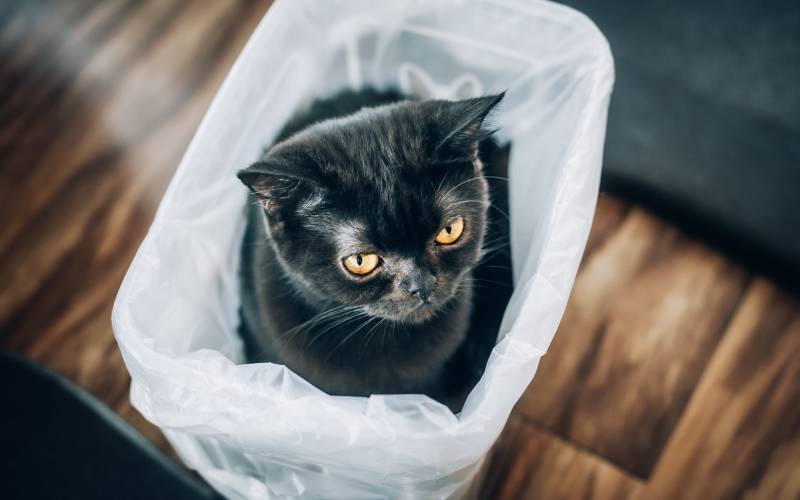
Why Do Cats Like Plastic Bags?
Cats are often attracted to plastic bags due to their unique sensory appeal. The crinkly texture and rustling sound of plastic bags can mimic the sounds of prey moving in the wild, triggering a cat’s hunting instincts. While this can trigger and elicit a completely normal behavior, there are much more things to consider, and the answer may not be as straightforward. In addition, it’s also essential to monitor this behavior closely to ensure your cat’s safety, as ingesting or playing with plastic bags can pose serious risks to their health.
The 7 Reasons Cats Lick Plastic
Here are a few reasons why your cat licks plastic bags and other plastic materials!
1. It Has an Interesting Sound
The crinkling sound of plastic bags can captivate a cat’s attention due to its resemblance to the rustling of leaves or the scurrying of small prey in the wild. This intriguing auditory stimulus can activate a cat’s hunting instincts, leading them to investigate the source of the noise. Cats are natural predators, and this sound may trigger their curiosity, making plastic bags irresistible playthings.
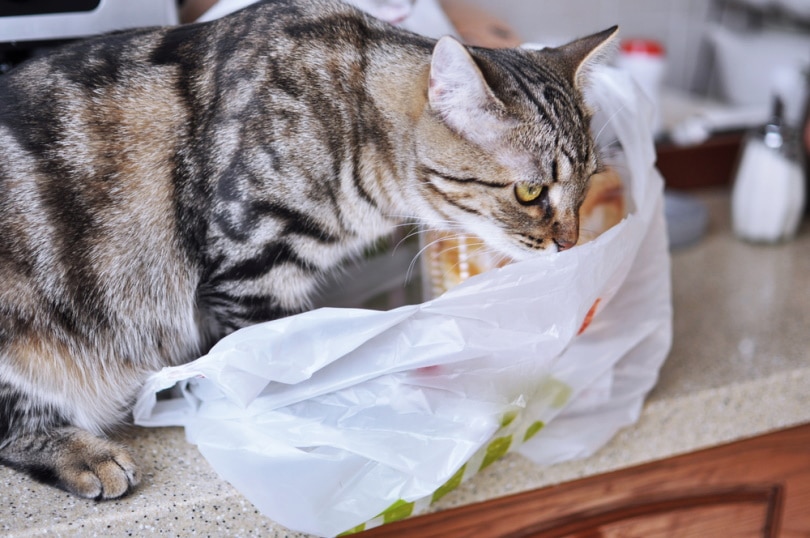
2. The Texture is Stimulating
Cats are tactile creatures, and they often explore their environment through touch. The smooth and slippery texture of plastic bags offers a unique sensory experience for cats compared to softer materials like fabric or paper. Running their paws across the plastic surface or biting into it can provide a satisfying tactile sensation.
Cats may enjoy the contrast between the cool, slick plastic and their sensitive whiskers or gums. This tactile stimulation can be pleasurable and entertaining for them, making plastic bags an attractive choice for play or exploration.
3. The Plastic Contains Corn Starch
Certain plastic bags, especially those marketed as eco-friendly or biodegradable, may contain corn starch or other plant-based additives. These materials can introduce enticing scents and flavors to the bags.
Cats, with their acute sense of smell and taste, might be drawn to these added elements in the plastic. The combination of the plastic texture and these natural additives can make the bags particularly appealing to felines. Cats may lick or chew on the bags to access these novel tastes, inadvertently causing ingestion.

4. The Lubricant Is Attractive
Plastic bags are often treated with lubricants during the manufacturing process to reduce friction and make them easier to handle. These lubricants can have a scent and taste that cats find attractive.
When a cat licks or chews on a plastic bag, they may be seeking to access the appealing flavor of this lubricant. While the lubricant itself is not a food source, cats might be drawn to it due to its unusual taste, leading to their continued interest in plastic bags.
5. It Smells Like Food
Cats possess an extraordinary sense of smell, allowing them to detect even faint odors. Plastic bags that have previously contained food items can retain residual scents, making the bags smell like potential sources of nourishment to a cat.
This lingering food odor can be highly enticing, leading a cat to investigate the bag, paw at it, or even lick it in an attempt to access the perceived food.
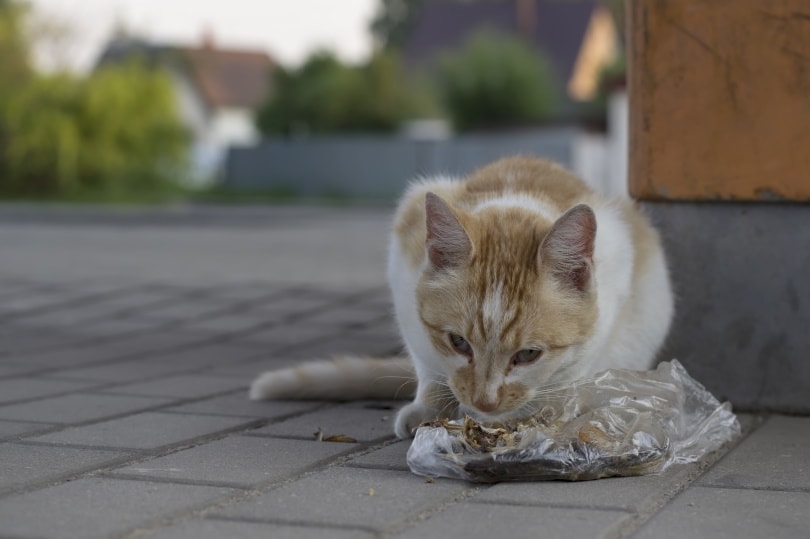
6. It Has a Unique Smell
Beyond food-related scents, plastic bags can emit a distinct chemical odor that can pique a cat’s curiosity. Cats have an exceptional ability to detect various scents, and this unique smell emanating from plastic can make it intriguing to them.
While humans may find plastic odors unappealing, cats may have a different perspective on these scents. Their investigation of the plastic may be driven by a combination of their heightened sense of smell and their natural tendency to explore novel odors in their environment.
7. Pica
Pica is a behavioral disorder characterized by the consumption of non-food items, such as plastic, paper, or fabric. While some cats may engage in occasional and harmless plastic licking or chewing out of curiosity or playfulness, persistent and compulsive ingestion of non-food items can indicate a more serious problem.
Pica can have various underlying causes, including nutritional deficiencies, medical conditions, stress, or anxiety. Cats with pica may be at risk of ingesting substances that could harm their digestive tract or cause blockages. It’s crucial for pet owners to consult with a veterinarian if their cat displays signs of pica to identify and address any underlying issues, ensuring the well-being of their feline companion.
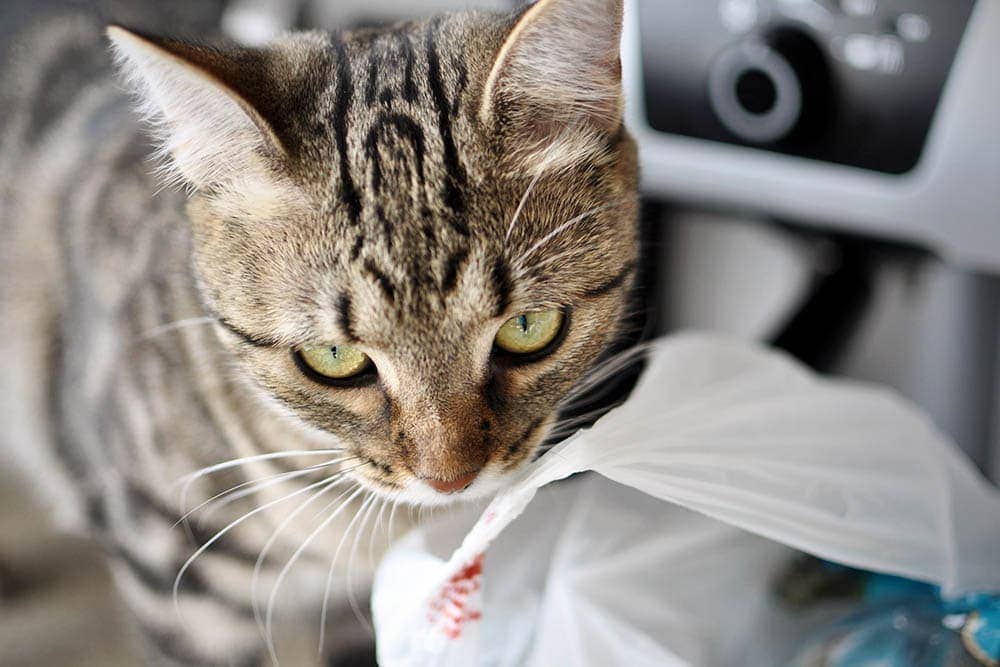
Can This Be a Cause for Concern?
While occasional licking or playing with plastic objects is generally considered a normal feline behavior, persistent and compulsive consumption of plastic, also known as pica, is indeed a cause for concern.
Pica can indicate underlying medical problems, nutritional deficiencies, or psychological stress in cats. Ingesting plastic or non-food items poses serious health risks, including the potential for digestive tract blockages, intestinal injuries, and toxicity from ingested materials.
Therefore, if you observe your cat consistently engaging in plastic consumption or any unusual behavior, it is advisable to consult with a veterinarian promptly to diagnose and address the root cause, ensuring the well-being of your furry friend.
How Can I Stop My Cat from Licking Plastics?
To deter your cat from licking plastic, you can employ a combination of strategies. First, remove access to plastic items by storing them out of your cat’s reach. Instead, provide engaging and cat-friendly toys to redirect their attention. Consider using pet-safe deterrent sprays on plastic objects, as these can discourage licking due to their unpleasant taste or scent.
Ensure your cat has a stimulating environment with plenty of mental and physical enrichment through interactive play, scratching posts, and puzzle feeders to alleviate potential boredom or stress, which may contribute to this behavior. If the plastic licking persists despite these efforts or appears compulsive, consult with a veterinarian to rule out any underlying medical issues or nutritional deficiencies that may be driving the behavior, and explore behavior modification techniques or medications as recommended by your vet.

Final Thoughts
The fascination that many cats exhibit towards plastic objects, particularly plastic bags, stems from a complex interplay of sensory, instinctual, and environmental factors. The crinkling sound and smooth texture of plastic, coupled with enticing scents and tastes from residual food or additives, often captivate a cat’s curiosity.
While occasional plastic exploration is generally harmless, vigilant pet owners should be aware of the potential risks associated with persistent plastic consumption, including pica-related complications. To ensure the health and well-being of our feline companions, it is crucial to monitor their interactions with plastic items, provide appropriate alternatives for stimulation, and seek veterinary guidance when needed!
Featured Image Credit: Mirahybrid, Shutterstock







